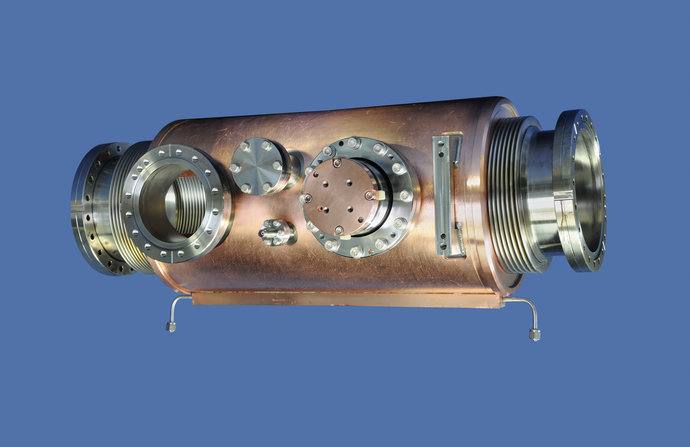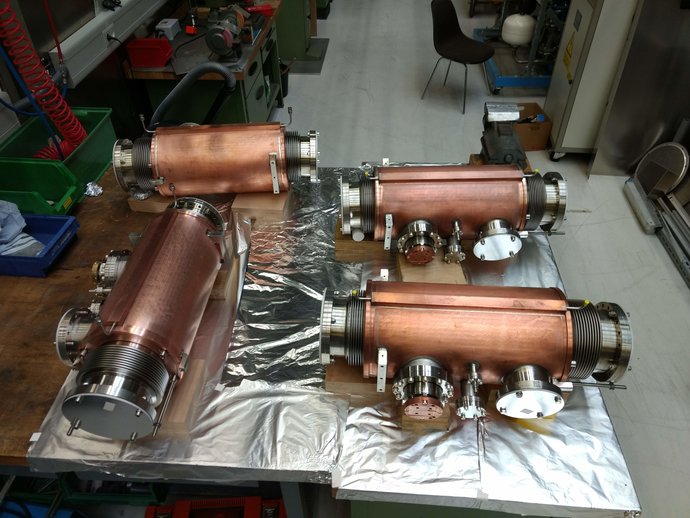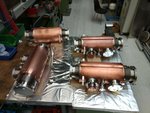SIS100 Cryocollimators
In the future ring accelerator SIS100, there will be 60 discharge collimators in the cryogenic regions, so-called cryocollimators or cryocatchers. The lattice of the SIS100, i.e. the ion-optical arrangement of the magnets, has been optimized in such a way that a highly localised loss distribution for the U28+→ U29+ recharge channel is created. These losses are concentrated in the regions between the superconducting quadrupoles. There, the cryocollimators are installed, which catch the recharged ions in a controlled way, with special low desorbing surfaces. In this way, dynamic vacuum effects are suppressed and stable beam operation at high heavy ion intensity is possible.
A prototype was built and its characteristics experimentally investigated. From the results obtained, a series design was developed and a first-of-series (FoS) device was initially manufactured. This was also subjected to various tests, which led to further enhancements for series production. Each chamber was subjected to various tests at the manufacturing plant and at GSI. By the end of 2020, series production was completed and the cryocollimators are ready for integration into the SIS100 quadrupole module.
Halo-Collimators
The halo collimators are used for machine protection. Their task is to selectively intercept beam particles before they are lost at sensitive aperture-limiting installations, typically electrostatic septa with their wires. Beam halo refers to particles that oscillate with large amplitudes around the ideal orbit. For example, a beam halo is created by resonances, when particles repeatedly and with the same angle, pass through the same magnetic field error. In this way, the amplitude of the particles increases until they can no longer be absorbed by the acceptance of the accelerator and are lost at the aperture.
There will be three different systems for halo collimation in SIS100:
- Proton Halo-Collimators are used to remove the beam halo in operation with protons and light or fully stripped ions.
- Ion Halo-Collimators are used in operation with partially charged ions to remove the beam halo
- Unavoidable systemic losses during slow extraction are captured by the third collimator system
All collimators and foils are designed in such that it is possible to measure the electric charge deposited by striking beam particles.
Proton-Halo-Collimation
The system for Proton Halo-Collimation is a so-called two-stage collimation system. In the first stage, the halo particles pass through a foil which is positioned close to the beam edge. The consequences are energy loss and scattering of the particles. In the further course of the beam, these particles move away from the core beam and can be intercepted by absorber blocks, the second stage. If only the absorber blocks were brought close to the beam, the halo particles would only just be able to reach them and most of them would be scattered out again. Then they would be lost at sensitive aperture-limiting installations, although they might be accelerated without loss, without the absorber block. The scattering in the first stage thus ensures that the halo particles to be removed strike the absorber blocks with sufficient distance to the outer surface so that they do not leave the absorber block in the following scattering processes until they come to stop.
Proton collimation achieves 900% collimation efficiency for protons in cooperation with the cryocollimators for selected working points. It can be used not only for protons, but also for light, fully stripped ions (beam particles without electrons). For heavy, fully stripped ions the collimation efficiency decreases, but in principle the system can also be used for such types of ions as well.
Ion-Halo-Collimation
The system for Ion-Halo-Collimation uses the fact that partially charged beam ions still carry electrons, which can be partially removed by passing through a foil at the edge of the beam. These stripped ions are separated from the circulating beam when passing through magnets and can be stopped by collimator blocks. As with Proton-Halo-Collimation, these blocks do not need to be close to the edge of the beam.
Collimator System to control Systematic Extraction Losses
Beam operation with slow extraction will result in unavoidable systematic losses. Beam particles interacting with wires of the electrostatic extraction septum can change their charge state and be scattered. They get lost in the further process. In order to control the pressure increase due to uncontrolled extraction losses and to avoid unnecessary activation of accelerator components, there is a system of three collimator pairs on the extraction line to absorb these losses in a controlled manner.
The difficulty in the design is to dissipate the energy deposited by the ions. Depending on the operating mode and collimator, power losses of up to 370W are expected.
Internal Beam Dump
The Internal Beam Dump or Emergency Beam Dump is used to quickly destroy the beam in the event of a fault. It is located under the third extraction septum. The beam can be destroyed here by the extraction kicker not kicking the beam upwards for extraction, but downwards into the beam dump.
The dump consists of graphite and tungsten blocks. The challenge is that the dump must work with all beams that can be accelerated in the SIS100.







